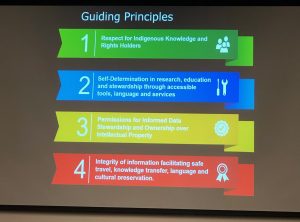SIKU website (beta until April 2019)
An important audience for Smith’s (1999) Decolonizing Methodologies: Research and Indigenous Peoples would be indigenous academics and researchers who may be developing indigenous research agendas, methodologies and protocols. She says:
“It appalls us that the West can desire, extract and claim ownership of our ways of knowing, our imagery, the things we create and produce, and then simultaneously reject the people who created and developed those ideas and seek to deny them further opportunities to be creators of their own culture and own nations.” (p. 1).
SIKU is an Indigenous Knowledge Wiki and Social Mapping Platform that was initially inspired by a Facebook secret group page entitled “Nunavut hunting stories of the day”. Indigenous people want to share about their communities, their environmental monitoring practices, what they see every day on the land, and generally what they know, but using platforms like Facebook to do it, or, simply sharing with family, friends orally – without a wider audience. When using a platform like Facebook, users are relinquishing their intellectual property to Facebook when they post. It is also difficult to find certain posts in a group (much scrolling is required – not very efficient).
So, SIKU was developed to address this concern and developers created a platform to preserve Indigenous peoples’ intellectual property as their own, so that they can share knowledge in a respectful way. This is very important to Indigenous people. Here are the guiding principles of SIKU:

SIKU’s Guiding Principles
Below is a chart to illustrate the process for data stewardship when adding/posting items to the SIKU platform.

All users must agree to the Terms of Reference when signing up / creating an account, and when they agree to these terms, they must abide by the guiding principles when posting / interacting with information within the app and beyond. What is interesting is that developers make it clear that everyone is to work within existing governance structures outlined by the communities.